First Aid Essentials for Parents: Be Prepared for Life’s Little Emergencies

- Being prepared for an emergency will help keep your family safe and prevent expensive visits to urgent care.
- A home first aid kit should include basic bandages, medications, and ointments.
- Older members of your family should know basic CPR and choking rescue.
- Even young children can learn how to dial 911 in an emergency.
Every family deals with little emergencies every so often. Whether it is a cut, a bump on the head, or something more serious, being prepared can make all the difference. It’s much better to be overprepared and overtrained than to find yourself in a scary situation with no idea what to do.
A good first aid kit, knowledge about first aid for families, and teaching children basic safety rules can help you avoid or deal with everything from small inconveniences to devastating emergencies.
The Must-Have Components of a Family First Aid Kit
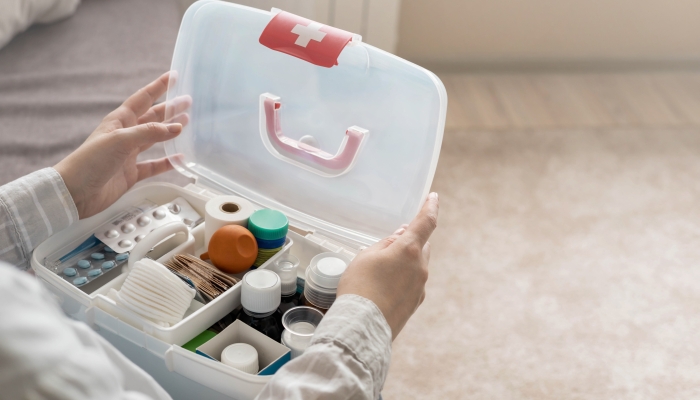
A family first aid kit doesn’t have to be expensive or complicated. A small kit with basic first aid supplies is enough to deal with most common medical emergencies.
Basics Supplies
Experts at St. Luke’s University Health Network11. 5 Common Home Accidents and How to Prevent Them. St. Luke’s University Health Network. 2017. https://www.slhn.org/blog/2015/5-common-home-accidents-and-how-to-prevent-them state that some of the most common injuries at home include cuts, burns, and injuries from falls. While some of these types of injuries require emergency medical care, small cuts, bruises, and minor burns can be taken care of at home with these basic supplies, such as:
- Sterile gauze pads
- Adhesive bandages
- Antiseptic wipes or solution
- Roller bandages
- Adhesive tape
- Tweezers and scissors
- Instant cold pack
Medications and Topical Treatments
For deep cuts and burns, you may need to apply medication or topical ointment to the injury or wound. Mild pain, small cuts, some swelling, and even mild allergic reactions can be dealt with by a family member with some first-aid skills.
Medications parents can use for minor injuries include:
- Pain and fever reducers like ibuprofen and acetaminophen
- Antihistamine for allergic reactions
- Hydrocortisone cream for skin irritation
- Aloe vera gel for burns
- Oral rehydration solutions for dehydration
- Emergency medications like epi-pens, insulin, or glucagon
If your child has a severe allergy, special needs, or diabetes, make sure you talk to your medical provider about the types of medications you need to have available for them. While your child should always have their emergency medications nearby, it’s a good idea to keep an extra dose in your family’s first-aid kit.

Specialized Tools
Some tools you’ll want in your first aid kit are:
- Thermometer (forehead or ear for children)
- Nasal aspirator for infants
- Child-safe syringe or dosing spoon for liquid medications
- Dechoking device
Dechoking devices have gained popularity in recent years, and research on these devices is encouraging. The International Journal of Environmental Research and Public Health22. Dunne, C. L., Osman, S., Viguers, K., Queiroga, A. C., Szpilman, D., & Peden, A. E.. Phase One of a Global Evaluation of Suction-Based Airway Clearance Devices in Foreign Body Airway Obstructions: A Retrospective Descriptive Analysis. International Journal of Environmental Research and Public Health. 2022;19(7), 3846. https://doi.org/10.3390/ijerph19073846 recently published a study showing that these devices can be an effective tool for a child choking on food or other items.
List of Emergency Numbers
Some problems like accidental poisonings require the advice of a medical professional. While smartphones make getting a hold of emergency numbers much easier, you should still keep a list of emergency contact information in your first aid kit.
Some phone numbers you’ll want to have listed include:
- Poison control
- Your local police department
- Your child’s pediatrician
- A neighbor you can call for assistance
- Emergency veterinarian
Common Childhood Emergencies and How to Handle Them
While having a good first aid kit is important, you also need to know how to use the supplies you have. Organizations like the Red Cross33. Red Cross training: Take A class. Red Cross. 2022. https://www.redcross.org/take-a-class offer basic first-aid training for families. These trainings teach families how to handle everything from small scrapes to starting CPR while you wait for emergency help.
Cuts and Scrapes
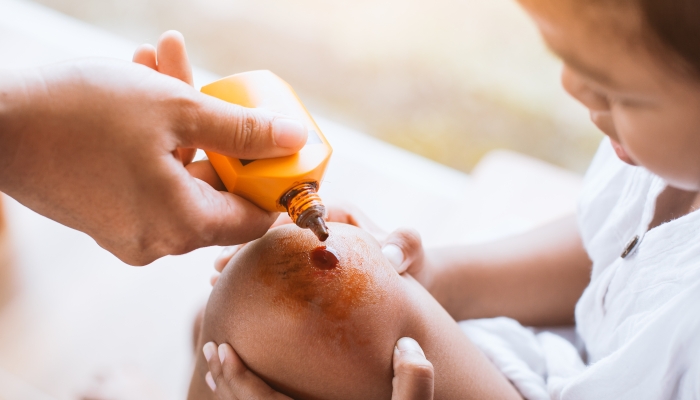
Most cuts and scrapes at home are minor and can be treated without medical help. If someone in the family gets a small cut or scrape, simply use a clean cloth and cool water to remove dirt or debris from the area, apply antibiotic ointment, and apply an adhesive or elastic bandage.
For larger cuts with a lot of bleeding, you should apply direct pressure to the injured area. While seeing a lot of blood can be scary, try to remain calm. If the area does not stop bleeding within a few minutes or there is a significant amount of bleeding, go to the nearest emergency department or call 911.
The Cleveland Clinic44. Cleveland Clinic Medical Professional. Hemorrhage: What is it, causes & when to call the doctor. Cleveland Clinic. 2021. https://my.clevelandclinic.org/health/symptoms/21654-hemorrhage recommends applying a tourniquet in cases of severe bleeding. A tourniquet should be placed just above the wound, closer to the heart. These should only be used when absolutely necessary, as they could cause further harm to a bleeding limb.
Burns
Burns can be caused by an open flame, too much sun exposure, contact with chemicals, a hot stove, or even hot bath water. Small first-degree burns require only first aid from family members at home, while larger or deeper burns require the help of emergency services.
If a burn is near the eyes, is larger than 3 inches in diameter, affects more than the top layer of skin, begins swelling right away, or has patches of brown, white, or black, you’ll need to seek medical care.
For first-degree, or minor, burns, you should run the burned area under cool water, apply lotion like aloe vera, and wrap the burn in a loose bandage. Even minor burns can be painful, but an over-the-counter pain medication should help.
Choking

According to the National Safety Council55. Choking Prevention and Rescue Tips. National Safety Council. https://www.nsc.org/community-safety/safety-topics/choking, choking is one of the most common causes of accidental death in children under the age of four.
Hot dogs, grapes, balloons, and hard candies are some of the most common things children get stuck in their throats. You can prevent choking in your child by cutting their food into bite-sized pieces and keeping balloons, marbles, and other small items out of their reach.
The Heimlich maneuver can help adults and older children who are choking.
This is done by standing behind the choking person and wrapping your arms around them. Then, place a fist just above their belly button and grab your fist with the other hand. Once your hands are placed correctly, perform abdominal thrusts by pulling your fist inward and upward. Continue these motions until the item is dislodged or the victim becomes unconscious.
For very young children and infants, choking assistance is different.
If your infant or young baby is choking, you can try to clear their airway by laying their body face down over your forearm and leg and performing five back blows using the heel of your hand, hitting between the shoulder blades. Then, turn their body so they are lying facing upward and perform five chest thrusts, using two fingers and compressing just below the nipple line.
While one person is providing rescue care, another person should be calling emergency services for help.
Ingestion of Foreign Substances

Small children are notorious for putting everything in their mouths. Not only does this put them at risk for choking, but kids who drink soaps or cleaning products can become extremely ill. Other items like magnets, sharp tools, and batteries can be extremely dangerous.
If your child swallows a non-food item, it’s best to call your pediatrician right away. While small coins or beads are harmless if swallowed, some items like magnets or dead batteries can be life-threatening.
If your child drinks something that might be harmful, call your local poison control center to find out what to do. Do not force your child to throw up, since the substance may burn their throat on the way back up from the stomach.
The National Capital Poison Center has an online tool and phone number that can help you decide what to do. Visit their website66. Get Help Online or By Phone. Poison Control. https://www.poison.org or call 1-800-222-1222 for help.
Head Injuries
Head injuries are often caused by falls from playground equipment, bikes, or scooters. A head injury can range from a mild bump to a severe traumatic brain injury. Ensuring that your child always wears a helmet is the best thing you can do to prevent a scary head injury.
If your child does fall and hit their head, there are a few things you should pay attention to. If your child loses consciousness, has difficulty concentrating, does not remember what happened, or complains of a headache after their accident, it’s best to get them checked out by a doctor. Any of these symptoms may indicate a concussion.
Most children who suffer from a mild concussion make a full recovery. Your doctor may recommend a few days of rest for your child before they can return to school or their other normal activities.
Child CPR and Rescue Breaths
Most parents are terrified of the thought of having to perform CPR on their child. However, if you can start CPR right away, chances of survival increase significantly.
According to the American Heart Association77. CPR Facts & Stats. cpr.heart.org. https://cpr.heart.org/en/resources/cpr-facts-and-stats, bystander CPR increases the chance of victim survival by 200-300%. Unfortunately, only about 40% of those who suffer a cardiac arrest outside of the hospital get the immediate help that they need.

Basics of CPR for Infants and Children
While it can be stressful to start CPR, remember that in the case of a cardiac arrest, doing something is always better than doing nothing.
The following steps are recommended by the Red Cross88. Adult CPR Steps. Red Cross. https://www.redcross.org/take-a-class/cpr/performing-cpr/cpr-steps:
- Check the scene for safety. You cannot help someone if you are in danger yourself.
- Assess whether or not the child is responsive. Tap their shoulder and shout.
- If they are unresponsive, check for a pulse and breathing for no longer than 5 seconds.
- Send someone to call 911.
- Place the child or infant flat on their back on a firm surface, and kneel next to them.
- Give 30 chest compressions at a rate of about 100 per minute.
- For an infant, use two fingers to give compressions.
- For a child, use the heel of one hand to give compressions.
- For an older child or adult, use two hands to give compressions.
- After giving 30 compressions, tilt the chin of the victim back slightly and give two rescue breaths
- Watch for their chest to rise with each breath.
- Continue CPR until emergency medical services arrive.
Rescue Breaths
If the child in need of assistance has a pulse but is not breathing, you can provide rescue breaths only. To give a proper rescue breath, follow these steps:
- Lay the person flat on his or her back.
- Tilt the head back slightly to open the airway.
- Place a mouth barrier over their mouth if you have one.
- Put your mouth over the victim’s mouth and nose, creating as tight of a seal as possible.
- Gently blow air into the mouth, watching for their chest to rise.
- If the chest does not rise, check to see if the airway is obstructed. You may have to tilt the head back more or less to open the airway.
Continuous Learning: Regularly Update CPR Knowledge
Unless you work as a first responder, you probably do not practice cardiopulmonary resuscitation or chest compressions very often. While CPR is not very complex, it can be hard to remember what to do under that much pressure.
Attending a CPR course regularly is a good way to keep up with your skills. While the chances of you ever having to start CPR are low, knowing what to do in a worst-case scenario may save someone’s life.
Educating Children on Safety and First Aid
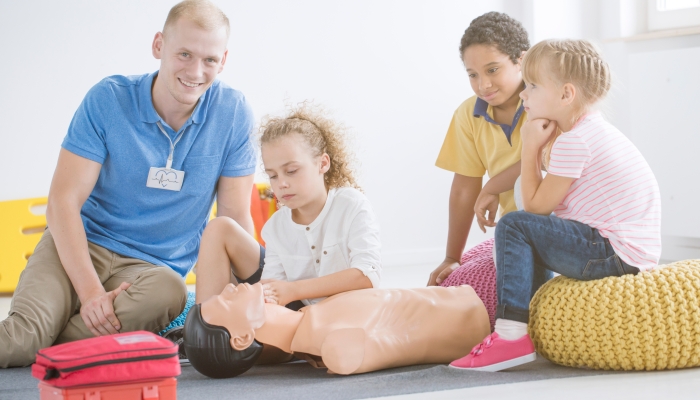
Teaching children about safety is not a one-time lesson. Frequent reminders about safety and discussions about what to do in an emergency are the best ways to solidify the information in your child’s mind.
Age-Appropriate Safety Lessons
You should start teaching your child about how to be safe from the moment they become mobile. Helping your child understand water safety, fire safety, and not to eat or drink non-food items is an essential part of keeping them safe and healthy.
Young children should also be taught that wearing a seatbelt, life jacket, and helmet are non-negotiable. Even for short rides or slow bike rides around the block. A good general rule is: that if it has wheels, it requires a seatbelt or helmet. There should be no exceptions to this rule.
Children should also wear a life jacket whenever they are playing in or around water. A life jacket is not a substitute for close supervision.
Introduce Basic First Aid Skills
As your child gets a little older, they can learn basic first aid skills. Six or 7-year-olds can learn to clean a small wound with water and place a bandage on a cut.
Depending on their emotional maturity and development, children this age may also be able to learn to use autoinjectors like epi-pens or glucagon in an emergency.
Calling 911
Children can learn to deal with an emergency as young as four or five years old. While children that young will not be able to administer first aid, they can learn how to call 911.
References
- 5 Common Home Accidents and How to Prevent Them. St. Luke’s University Health Network. (2017, October 11). https://www.slhn.org/blog/2015/5-common-home-accidents-and-how-to-prevent-them
- Dunne, C. L., Osman, S., Viguers, K., Queiroga, A. C., Szpilman, D., & Peden, A. E. (2022). Phase One of a Global Evaluation of Suction-Based Airway Clearance Devices in Foreign Body Airway Obstructions: A Retrospective Descriptive Analysis. International Journal of Environmental Research and Public Health, 19(7), 3846. https://doi.org/10.3390/ijerph19073846
- Red Cross training: Take A class. Red Cross. (n.d.). https://www.redcross.org/take-a-class
- Cleveland Clinic Medical Professional. (2021, July 14). Hemorrhage: What is it, causes & when to call the doctor. Cleveland Clinic. https://my.clevelandclinic.org/health/symptoms/21654-hemorrhage
- Choking Prevention and Rescue Tips. National Safety Council. (n.d.). https://www.nsc.org/community-safety/safety-topics/choking
- Get Help Online or By Phone. Poison Control. (n.d.). https://www.poison.org
- CPR Facts & Stats. cpr.heart.org. (n.d.). https://cpr.heart.org/en/resources/cpr-facts-and-stats
- Adult CPR Steps. Red Cross. (n.d.). https://www.redcross.org/take-a-class/cpr/performing-cpr/cpr-steps
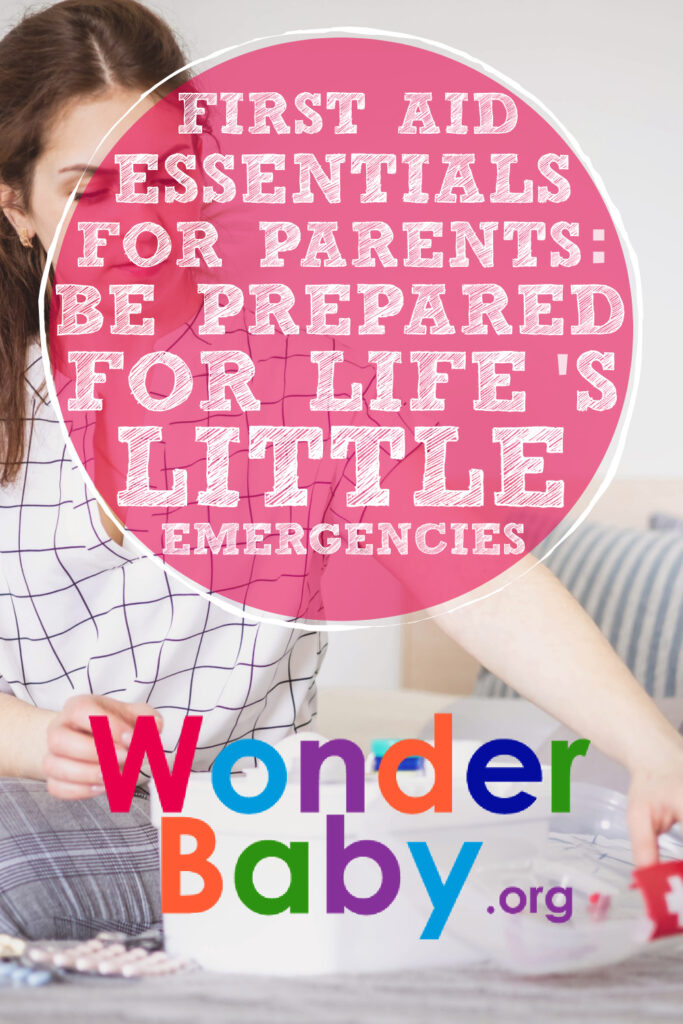
The information WonderBaby provides is not intended to be, and does not constitute, medical or other health advice or diagnosis and should not be used as such. Always consult with a qualified medical professional about your specific circumstances.
Related Posts

Eye Conditions and Syndromes, Visual Impairment
Neuralink Announces Plans to Restore Sight to the Blind with Brain Chip
Elon Musk’s company Neuralink has announced plans to begin human trials of its new “Blindsight” brain chip by the end of 2025.
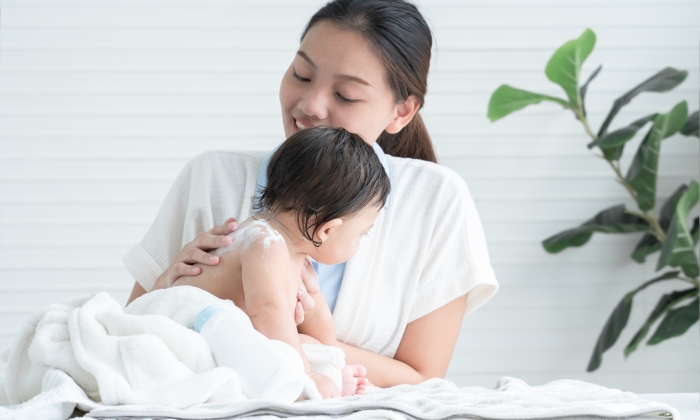
Health & Nutrition
Can Baby Skin Care Products Expire?
Is that forgotten tube of diaper rash cream still safe to use? Learn more about the expiration dates of popular skin care products for infants.

Health & Nutrition
Boosting Immunity in Kids: 3 Tips for a Healthy Winter
Parents can help boost their kids’ immunity during cold and flu season by maintaining healthy eating, sleeping, and exercising habits in the winter.